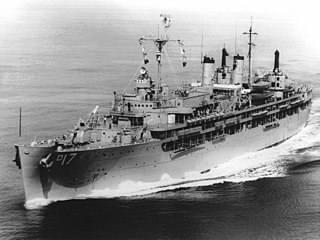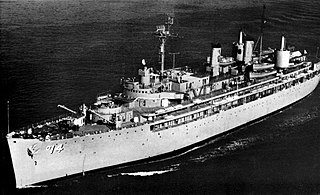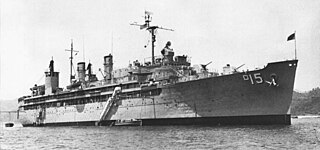
The Mare Island Naval Shipyard (MINSY) was the first United States Navy base established on the Pacific Ocean. It is located 25 miles (40 km) northeast of San Francisco in Vallejo, California. The Napa River goes through the Mare Island Strait and separates the peninsula shipyard from the main portion of the city of Vallejo. MINSY made a name for itself as the premier U.S. West Coast submarine port as well as serving as the controlling force in San Francisco Bay Area shipbuilding efforts during World War II.

USS Admirable (AM-136) was the lead ship of her class of minesweeper built for the United States Navy during World War II. In commission from 1943 to 1945, she was transferred to the Soviet Navy in 1945 and served as T-331 until stricken in 1958.

USS Craven (DD-70), later renamed USS Conway (DD-70), a Caldwell-class destroyer, was in commission in the United States Navy from 1918 to 1922 and briefly in 1940, and later in the Royal Navy as HMS Lewes from 1940 to 1945.

USS Clemson (DD-186/AVP-17/AVD-4/APD-31) was the lead ship of her class of destroyers which served in the United States Navy during World War II. She was named for Midshipman Henry A. Clemson (1820–1846), who was lost at sea when the brig USS Somers capsized in a sudden squall off Vera Cruz on 8 December 1846 while chasing a blockade runner. Entering service in 1919, the ship had a brief active life before placed in reserve in 1922. Converted to an aircraft tender in 1939, the ship reactivated in 1940. In 1943, Clemson reconverted to a destroyer and served in the Battle of the Atlantic during World War II. In 1944, the ship was converted into a high speed transport and transferred to the Pacific taking part in several invasions. Following the end of the war, the ship was taken out of service again and sold for scrapping in 1946.

USS Goldsborough (DD-188/AVP-18/AVD-5/APD-32) was a Clemson-class destroyer in the United States Navy during World War II. She was the second Navy ship named for Rear Admiral Louis M. Goldsborough (1805–1877). Entering service in 1920, the ship had a brief active life before being placed in reserve in 1922. Goldsborough was reactivated for World War II and was used as an aircraft tender, destroyer and high speed transport in both Atlantic and Pacific theaters. Following the war, the ship was sold for scrapping in 1946.

Charleston Naval Shipyard was a U.S. Navy ship building and repair facility located along the west bank of the Cooper River, in North Charleston, South Carolina and part of Naval Base Charleston.

The John C. Butler class were destroyer escorts that originated during World War II. The lead ship was USS John C. Butler, commissioned on 31 March 1944. The class was also known as the WGT type from their Westinghouse geared turbine drive. Of the 293 ships originally planned, 206 were canceled in 1944 and a further four after being laid down; three were not completed until after the end of World War II.

USS Piedmont (AD–17) was a Dixie-class destroyer tender built during World War II for the United States Navy. Her task was to service destroyers in, or near, battle areas and to keep them fit for duty. She served in the Pacific Ocean during World War II, the Cold War, the Korean War, and the Vietnam War. For her work in battle areas, the ship was awarded four battle stars for her Korean War efforts and one for Vietnam War service.

USS Arcadia was one of four Klondike-class destroyer tenders built at the tail end of World War II for the United States Navy, and the third U.S. Naval vessel to bear that name. Destroyer tenders were typically named after U.S. National Parks. However the destroyer tender AD-23 was apparently misnamed Arcadia in an effort to commemorate Acadia National Park in Maine.

The Dixie class destroyer tender was a class of five United States Navy destroyer tenders used during World War II. This class's design was based on the specifications of USS Dixie (AD-14) and constructed based on drawings for that vessel plus ongoing modifications specified for each continued vessel of the class. The basic hull and superstructure for this class was the same as the Fulton-class submarine tenders and Vulcan-class repair ships.

USS Bridgeport (AD-10/ID-3009) was a destroyer tender in the United States Navy during World War I and the years after. She was a twin-screw, steel-hulled passenger and cargo steamship built in 1901 at Vegesack, Germany as SS Breslau of the North German Lloyd line. Breslau was one of the seven ships of the Köln class of ships built for the Bremen to Baltimore and Galveston route.

USS Prairie (AD–15) was a Dixie-class destroyer tender built just before the start of World War II for the U.S. Navy. Her task was to service destroyers in, or near, battle areas and to keep them fit for duty. Prior to U.S. entry into World War II, Prairie cruised between Atlantic ports from Colon, C.Z. to Argentia, Newfoundland. She was docked at Argentia, tending Allied ships, on 7 December 1941 as the first direct blows of World War II struck the United States.

USS Sierra (AD-18) was a Dixie-class destroyer tender built just before the start of World War II for the U.S. Navy. Her task was to service destroyers in, or near, battle areas and to keep them fit for duty.

USS Yosemite (AD-19) was a Dixie-class destroyer tender built during World War II for the U.S. Navy. Her task was to service destroyers in, or near, battle areas and to keep them fit for duty.

USS Yakutat (AVP-32) was a United States Navy Barnegat-class small seaplane tender in commission from 1944 to 1946. Yakutat tended seaplanes in combat areas in the Pacific during the latter stages of World War II. After the war, she was in commission in the United States Coast Guard from 1948 to 1971 as the Coast Guard cutter USCGC Yakutat (WAVP-380), later WHEC-380, seeing service in the Vietnam War during her Coast Guard career. Transferred to South Vietnam in 1971, she was commissioned into the Republic of Vietnam Navy as the frigate RVNS Trần Nhật Duật (HQ-03). When South Vietnam collapsed in 1975 at the end of the Vietnam War, she fled to the Philippines, where the Philippine Navy took custody of her and cannibalized her for spare parts until discarding her in 1982.
Tampa Shipbuilding Company, or TASCO, was one of a number of shipyards in Tampa, Florida. It operated from 1917 to after World War II, closing in 1947.

The Seattle-Tacoma Shipbuilding Corporation was an American corporation which built escort carriers, destroyers, cargo ships and auxiliaries for the United States Navy and merchant marine during World War II in two yards in Puget Sound, Washington. It was the largest producer of destroyers (45) on the West Coast and the largest producer of escort carriers of various classes (56) of any United States yard active during World War II.

The Shenandoah-class destroyer tenders were a class of destroyer tenders built for the United States Navy that served from 1945 to 1984.

The Altair class destroyer tender was a class of three United States Navy destroyer tenders. These ships were built in Skinner & Eddy's Seattle shipyard as commercial cargo ships during World War I, and acquired by the Navy when the shipyard closed in 1921. All three served through World War II, and were decommissioned and scrapped shortly after the war.

USS Arrowhead (AD-35) was a planned Shenandoah-class destroyer tender of the United States Navy during World War II. She was laid down at Puget Sound Naval Shipyard on 1 December 1944. Due to the defeat of Germany, and atomic bombings of Hiroshima and Nagasaki, Japan, her construction was cancelled on 11 August 1945, shortly before the war's end.


















